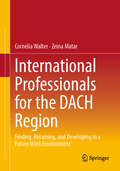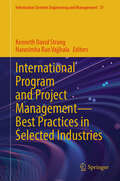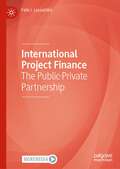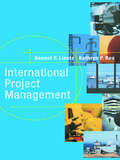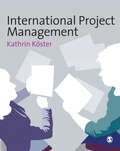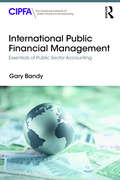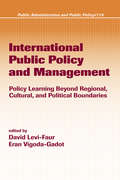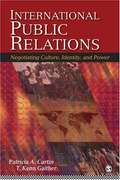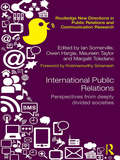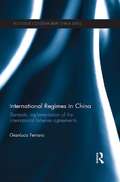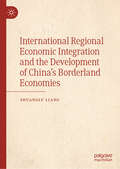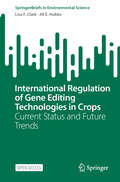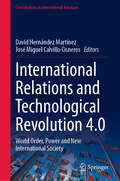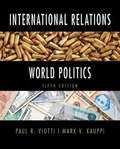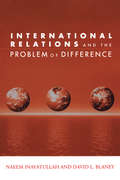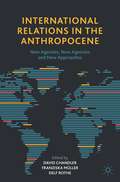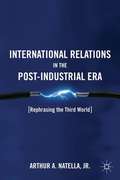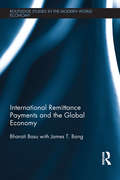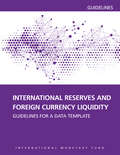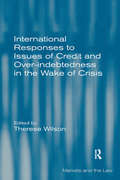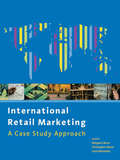- Table View
- List View
International Professionals for the DACH Region: Finding, Retaining, and Developing in a Future Work Environment
by Cornelia Walter Zeina MatarThis book presents the necessary resources and practical options for companies to find, bind, and develop international professionals in the DACH region. Through a study conducted by the authors, the interrelationship between Human Resources and internationality is analyzed. The book is organized around the Employee Experience and is suitable for executives, managers, leaders, communication and HR departments, as well as relocation and personnel services.
International Profit Associates
by Thomas J. Delong Ashish Nanda Monica MullickDescribes the work environment, systems, and processes that allow International Profit Associates (IPA) to follow a systematic four-step approach to providing advisory service to small business owners.
International Program and Project Management — Best Practices in Selected Industries (Information Systems Engineering and Management #31)
by Narasimha Rao Vajjhala Kenneth David StrangThis book examines the latest best practices in international program and project management, offering invaluable insights across various industries. Edited by renowned experts, this book brings together a diverse range of case studies and research from leading scholars and practitioners worldwide. From a detailed macro-environmental analysis of contemporary project management to exploring the complexities of AI project management, each chapter highlights critical strategies, tools, and methodologies needed to tackle today's evolving challenges in program and project management. Topics such as ISO standards, ISO 21502, project management body of knowledge (PMBOK), risk management in high-complexity environments, stakeholder management, and agile business intelligence projects are discussed through practical case studies from industries ranging from fintech and biopharmaceuticals to public administration. This book is an essential resource for project managers, researchers, and industry professionals seeking to enhance their understanding of global project management dynamics and apply cutting-edge approaches across sectors. Chapter 7 is available open access under a Creative Commons Attribution 4.0 International License via link.springer.com.
International Project Finance: The Public-Private Partnership
by Felix I. LessamboEconomic growth and development critically depends on the quality of infrastructure. Each aspect of the economy and its infrastructure are linked systemically. Public-Private Partnerships (PPPs) are increasingly being promoted as the solution to the shortfall in financing needed to achieve the Sustainable Development Goals (SDGs). Public-private partnerships enable the public entity to utilize the expertise and efficiencies of the private sector to deliver services and facilities that traditionally have been delivered by the public sector, either through public sector employees or by traditional procurement methods. To be beneficial to all stakeholders, a PPP project requires careful planning, implementation, and strong governance. This book breaks down the steps involved and the traps to circumvent.Despite its globally growing importance, project finance has been somewhat underrepresented in research. This book analyzes project finance from an interdisciplinary perspective—finance, management, and international business—and includes international laws of arbitrage and perspectives of international financial institutions as never endeavored by any previous research projects. The book also includes case studies assessing the relevance of private-public partnerships by comparing the country expectations and the real outcomes. The gap between expectations and results does not necessarily mean that significant progress has not been made. To the contrary, the book suggests that some of the original targets set may have been unrealistic, and that the requisite financial resources—or the financial sector policies that could have generated those resources—may have been lacking.
International Project Management
by Bennet Lientz Kathryn Rea'International Project Management' provides specific guidelines for achieving greater project success. It is the result of 15 years of work on international projects by the authors across various project areas and industries. The authors address a need for modern techniques in project management geared and suited to international projects. They offer lessons learned from failures and problems in international projects, and suggest alternative solutions for project issues. Industry examples include manufacturing, distribution, communications, media, transportation, government, IT, marketing, energy, medical care, tourism, and others in forty countries across five continents. The purpose of this book is to answer: * What is an international project and why is it different? * What are the critical success factors for managing international projects? * How are vendors and outsourcing managed across national boundaries? * How do businesses effectively address cross- cultural, social, and political issues? * How are international communications set up and coordinated? * What should a manager look for in an international project leader? * How does a business select the right vendors for an international project? * How are inadequate or incompatible infrastructure and technology issues overcome? * How are the legal and bureaucratic limitations on project management dealt with?
International Project Management
by Kathrin KosterWith project management becoming an increasingly global endeavour, a comprehensive and international student text that reflects this reality is essential.<P> International Project Management does just that, systematically linking the key elements of cross-cultural management and the particularities of an international context, with the tools and techniques of project management.<P> Key features include:<P> - A wide variety of examples and illustrations, including an in-depth, end-of-chapter case study with case questions;<P> - Student exercises and review questions;<P> - Detailed further reading<P> - The full support of a Companion Website, featuring a Teacher's Manual<P> Visit the Companion Website at www.sagepub.co.uk/koster
International Public Financial Management: Essentials of Public Sector Accounting
by Gary BandyRunning public sector organizations requires specialist accounting and finance skills to overcome the unique challenges of the sector. Citizens rely on their governments to provide a wide range of public services from an inevitably limited budget and therefore the better that the public money is managed the more services that can be delivered. Just as there is no single best way to manage a business there is no single best way to manage public finances. Co-published by the Chartered Institute of Public Finance and Accountancy (CIPFA), the world's leading professional public finance accountancy body, International Public Financial Management: Essentials of Public Sector Accounting provides an expert introduction to public sector accounting and finance. This book was conceived to accompany CIPFA’s International Public Financial Management (IPFM) qualifications as a resource for students that seeks to capture the essential elements of the modules they study, and reflects good practice as put forward by CIPFA in its examination syllabuses. Students of public management and public sector accounting will find this a useful text. Practitioners working in the public sector will also find this concise book vital reading in seeking value for money in providing public services.
International Public Policy and Management (Public Administration and Public Policy)
by Eran Vigoda-Gadot David Levi-FaurAn impressive study of economic, state, social, and international restructuring, International Public Policy and Management explores new patterns and advances in the global integration of policies that result from an ever-increasing pace of shared knowledge, regulations, and norms in countries around the globe. It considers the impact of globalized
International Public Procurement
by Khi V. ThaiSince the 1990s, government at all levels is under increasing pressure to do more with less. However, despite the U. S. government spending about 15 to 20 percent of its GDP on contracts for goods and services, there is a paucity of reference books for public procurement officials and very few textbooks for courses on the subject. Filling this void, the International Handbook of Public Procurement provides the knowledge necessary to understand how procurement works and how to improve the cost-effectiveness of procurement systems. Taking a multidisciplinary approach, the book focuses on the managerial, economic, political, and legal aspects of this topic. It begins with a conceptual framework and highlights various reforms occurring in certain countries. By examining these improvements, readers are able to apply this knowledge to their own strategies. The next section presents selected cases that illustrate the public procurement process, examining systems in various nations including Germany, China, South Africa, Cambodia, Uganda, and Estonia. The book also discusses the rise of electronic procurement systems (E-procurement) and reviews the benefits of these efficient systems. Other topics presented in this comprehensive volume include practical discussions on contract negotiations, bidding, price strategies and cost analysis, and an insightful chapter on the marketOCOs response to contract award announcements. A virtual encyclopedia from numerous international experts, this book was assembled by Khi V. Thai, Professor at Florida Atlantic University and Editor of the Journal of Public Procurement. Dr. Thai has provided technical assistance in the area of public procurement to governments across the world. Empowering those on all sides of the issue, this volume dispenses advice valuable to agovernment officials and contractors, as well as providing a comprehensive text for public administration students.
International Public Relations: Negotiating Culture, Identity, and Power
by Patricia A. Curtin T. Kenn GaitherInternational Public Relations: Negotiating Culture, Identity, and Power offers the first critical-cultural approach to international public relations theory and practice. Authors Patricia A. Curtin and T. Kenn Gaither introduce students to a cultural-economic model and accompanying practice matrix that explain public relations techniques and practices in a variety of regulatory, political, and cultural climates. offers the first critical-cultural approach to international public relations theory and practice. Authors Patricia A. Curtin and T. Kenn Gaither introduce students to a cultural-economic model and accompanying practice matrix that explain public relations techniques and practices in a variety of regulatory, political, and cultural climates.
International Public Relations: Perspectives from deeply divided societies (Routledge New Directions in PR & Communication Research)
by Ian Somerville, Owen Hargie, Maureen Taylor and Margalit ToledanoInternational Public Relations: Perspectives from deeply divided societies is positioned at the intersection of public relations (PR) practice with socio-political environments in divided, conflict and post-conflict societies. While most studies of PR focus on the activity as it is practiced within stable democratic societies, this book explores perspectives from contexts that have tended to be marginalized or uncharted. Presenting research from a diverse range of societies still deeply divided along racial, ethnic, religious or linguistic lines, this collection engages with a variety of questions including how PR practice in these societies may contribute to our understanding of PR theory building. Importantly, it highlights the role of communication strategies for actors that still deploy political violence to achieve their goals, as well as those that use it in building peace, resolving conflict, and assisting in the development of civil society. Featuring a uniquely wide range of original empirical research, including studies from Israel/Palestine, Mozambique, Northern Ireland, former Yugoslavia, former Czechoslovakia, Spain, Malaysia and Turkey, this groundbreaking book will be of interest not only to scholars of public relations, but also political communication, international relations, and peace and conflict studies. With a Foreword by Krishnamurthy Sriramesh, Editor of The Global Public Relations Handbook
International R&D Spillovers and Institutions
by Elhanan Helpman David T. Coe Alexander W. HoffmaisterA report from the International Monetary Fund.
International Regimes in China: Domestic Implementation of the International Fisheries Agreements (Routledge Contemporary China Series)
by Gianluca FerraroAccording to the Food and Agriculture Organization (FAO) of the United Nations, more than 80% of world’s fish stocks are fully exploited, over-exploited, depleted, or recovering from depletion. Although several international agreements have promoted more responsible fisheries, coastal states have usually maintained national policies that enable higher harvest levels rather than greater conservation of fish stocks, and international agreements for more responsible fisheries have generally experienced a weak domestic implementation. Among the major coastal fishing states, China constitutes the largest fish producer and main exporter in the world, and therefore presents a fascinating case-study for the domestic implementation of international fisheries agreements. This book investigates the degree to which China has complied with the international agreements it has signed, and asks why it is failing to meet expectations. Crucially, it calls for greater emphasis on the political, rather than technical, issues involved in the implementation of international regimes. In turn, it examines how understanding the case of China can help us to develop solutions for improved international compliance in the future. Providing an improved understanding of the implementation of international regimes, alongside an in-depth study of China’s political system, policy-making and compliance, this book will be of great interest to students and scholars of Chinese studies, international relations, public policy, and international law and environmental studies. It will also be useful for policy makers working in the fields of environmental regulation and fisheries management.
International Regional Economic Integration and the Development of China’s Borderland Economies
by Shuanglu LiangChina’s borderland economy has grown significantly recently, thanks largely to a favorable institutional environment created by national strategies such as the development of the western part of China, revitalization of old industrial bases in the northeast, and the anti-poverty campaign. This work draws on theories of international economics and spatial economics to study the regional economic integration of China's border areas, with the aim of shedding light on how to improve policies and practices. It discusses topics such as the transformation of border trade, industrial upgrading and urbanization in borderlands , especially in the context of cross-border economic integration. Furthermore, the book also explores ways in which changes in the border might contribute to the formation of peripheral economic growth centers, and related environmental, institutional and policy issues. It will interest scholars of Asian economic trends and the rise of China, particularly in Southeast Asia.
International Regulation of Gene Editing Technologies in Crops: Current Status and Future Trends (SpringerBriefs in Environmental Science)
by Jill E. Hobbs Lisa F. ClarkThis open access book analyzes the regulation and governance of gene editing in the global agrifood system as applications of gene editing, regulations and the intellectual property landscape continue to evolve. The primary focus of the manuscript is the dynamic interactions between regulatory frameworks and agricultural applications of gene editing in plant breeding. The goal is to give readers a holistic perspective on why the status of gene editing in agricultural applications is in a state of flux in some jurisdictions (e.g., the European Union) while more settled in others (e.g., Canada). Readers are provided with a clearer picture of what the future might hold for the use of gene editing in agriculture as a means to address food insecurity as the climate crisis grows and amid global geopolitical and economic turbulence.
International Relations and Technological Revolution 4.0: World Order, Power and New International Society (Contributions to International Relations)
by David Hernández Martínez José Miguel Calvillo CisnerosThis book analyzes the global implications of the fourth industrial revolution, the Technological Revolution 4.0, on International Relations. Examining the intersection of new technologies and international power, this volume engages in extensive discussions and debates surrounding the immediate and long-term consequences of innovations, such as artificial intelligence, big data, virtual reality, smart cities, and drones. The rapid and potent march of technological progress intensifies global curiosity and concern, particularly regarding control over these new technologies. The book discusses essential questions, such as the theoretical analysis of new technologies in international relations, their impact on the 21st-century world order, and the pivotal roles of international actors in this revolution. Finally, it examines how these new technologies are reshaping international security, cooperation, and communication. A critical resource for researchers and the general public, this book provides a contemporary and theoretical framework to contextualize the international discipline in light of the challenge posed by new technologies, while also discussing the key variables that mold international society in the 21st century within the parameters of this technological revolution. Moreover, it anticipates the prominent dynamics and challenges that will shape global structures, regions, and nations in the forthcoming decades.
International Relations and World Politics
by Paul R. Viotti Mark V. KauppiUpdated in its 5th edition, International Relations and World Politics is a toolkit that offers an authoritative survey of the field and practical ways to analyze current and future world problems. Drawn from the authors’ experience as scholars and practitioners, this new edition was completely rewritten to focus on an enduring teaching and learning goal–how individuals can apply theory, history, geography, and more for a lifetime of understanding politics in a globalized world. Whether as actors themselves in world politics, participants in the global economy, or simply readers of world news, those reading International Relations and World Politics not only get more help to master the field’s concepts but also get more help to understand that these are real-world ideas with real-world implications.
International Relations and the Problem of Difference
by Naeem Inayatullah David L. BlaneyInternational Relations and the Problem of Difference has developed out of the sense that IR as a discipline does not assess the quality of cultural interactions that shape, and are shaped by, the changing structures and processes of the international system. In this work, the authors re-imagine IR as a uniquely placed site for the study of differences as organized explicitly around the exploration of the relation of wholes and parts and sameness and difference-and always the one in relation to the other.
International Relations in the Anthropocene: New Agendas, New Agencies and New Approaches
by David Chandler Delf Rothe Franziska MüllerThis textbook introduces advanced students of International Relations (and beyond) to the ways in which the advent of, and reflections on, the Anthropocene impact on the study of global politics and the disciplinary foundations of IR. The book contains 24 chapters, authored by senior academics as well as early career scholars, and is divided into four parts, detailing, respectively, why the Anthropocene is of importance to IR, challenges to traditional approaches to security, the question of governance and agency in the Anthropocene, and new methods and approaches, going beyond the human/nature divide.
International Relations in the Post-Industrial Era
by Jr. Arthur A. NatellaThe current emphasis on the greening of the world marks a beginning of a new concern for our relationship with our planet. This book states that we are entering into a new era - a transitional time in history in which the values of the industrial revolution are being replaced by a post-industrial consciousness.
International Remittance Payments and the Global Economy (Routledge Studies in the Modern World Economy)
by James T. Bang Bharati BasuInternational Remittance Payments are described mainly as money sent by immigrants to their families and friends in their home countries. These payments provide an important source of income that is mostly used to provide for a variety of basic needs of the non-migrating members of immigrant families and thus remittance payments can be considered as a tool to reduce the poverty level of the labor sending countries. However, remittances are also used for asset accumulation by some families and for some countries they constitute a good part of foreign funds coming into the country. In-spite of their increasing volume over the last few decades, a lot of things about remittances are not known and studies estimate that about half of these money transfers are not even recorded. Since these payments are shown to reduce poverty and help economic progress in the remittance receiving countries, a better knowledge about remittances would help the debates surrounding immigration, remittances and their relation to the global economy.This book provides an overview of remittances in different parts of the world over the last thirty years. It looks at the labor sending and labor receiving countries separately. The text examines the trends, uses, motivations behind sending remittances, cost of sending them and how they are affected by the nature and the development level of different institutional factors.The remittance flows are growing over time and they are used mostly for reducing the uncertainty of life in the less developed parts of the world. However, motivation for sending remittances could be improved and thus remittances could be more conducive to economic development if 1) the relation between the remittance decision and the migration decision is better understood and 2) the costs of international money transfers are reduced. More studies about those issues would benefit the international community. Efforts should be made in all fronts to encourage such international flow of funds not only to have a redistribution of income all over the world, but also to synchronize the efforts towards global economic development and a better integration of the world economy. This book is aimed researchers, policy practitioners and post graduates studying International Economics or International Economic Relations or Political Science or Economic Development.
International Reserves and Foreign Currency Liquidity
by Anne Y. KesterInternational financial crises in the late 1990s revealed that deficiencies in countries' international reserves and related information made it difficult to anticipate and respond to crises by obscuring financial weaknesses and imbalances. This volume sets forth an innovative framework to assess countries' international reserves and foreign currency liquidity. The framework takes account of official balance-sheet and off-balance-sheet financial activities, future and potential demand for foreign exchange to meet official obligations, the availability of official foreign currency assets to meet such demand, and official risk exposure to exchange rate fluctuations. This work clarifies what international reserves are, and how international reserves and related information should be strengthened to promote informed decision making in the public and private sectors, thereby helping improve the functioning of global financial markets.
International Reserves and Foreign Currency Liquidity: Guidelines for a data Template
by International Monetary FundA report from the International Monetary Fund.
International Responses to Issues of Credit and Over-indebtedness in the Wake of Crisis (Markets And The Law Ser.)
by Therese WilsonThis book explores the political, economic and regulatory context in which credit regulation is taking place following the global financial crisis. It suggests that current neoliberal economic policies favour multi-national corporations rather than consumers and examines regulatory responses to the internationalization of consumer finance protection. Detailing how EU consumers have been affected by national economic conditions, the book also analyses the lending regimes of Europe, Australia, the US and South Africa and offers suggestions for responsible lending to avoid over-indebtedness and corrupt mortgage-lending. Finally, new approaches and directions for consumer credit regulations are outlined, such as protection for small businesses, protection against risky credit products, reorganization of mortgage securitization and the possibility of a partnership model to address financial exclusion. The book includes contributions from leading names in the field of consumer law and will be invaluable to those interested in banking, business and commercial law.
International Retail Marketing
by Christopher Moore Margaret Bruce Grete BirtwistleInternational Retail Marketing combines a broad thematic overview of the key issues concerning international retail marketing with a series of incisive cases and examples of industry practice from markedly different sectors as fashion, food and healthcare. The authors provide an accessible and wide-ranging outline of the fundamentals of the subject, such as trends in retail marketing, strategy and logistics, and buying and merchandise management within an international perspective. Contributions from Europe, North America and Asia show the dynamics affecting international retailing through a variety of case. Key discussion points are highlighted throughout the text, giving a hands-on focus.
